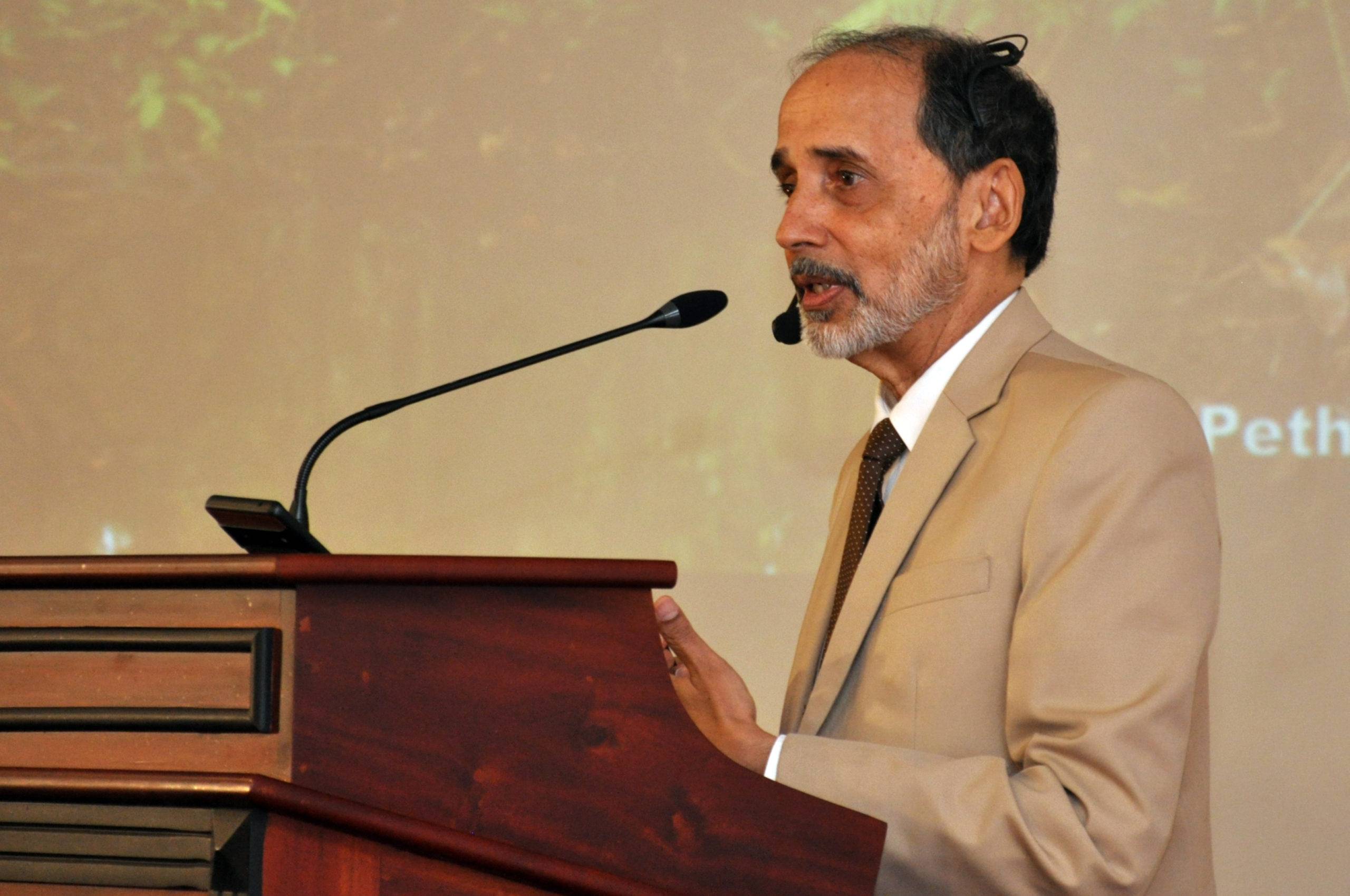
“LEVERAGE OR LIABILITY?” Conserving Biological Diversity in an Economic Collapse
Biodiversity Sri Lanka joined hands with the French Embassy, Bandaranaike Center for International Studies (BCIS), Dilmah Conservation, Commercial Bank, and MAS Kreeda in featuring world-renowned scientist, Sri Lankan author, and educator Dr. Rohan Pethiyagoda, as the keynote speaker at BSL’s flagship event in celebration of the International Day for Biological Diversity and World Environment Day, 2022.
The event was held on June 8th, 2022 at the Bandaranaike Center for International Studies (BCIS), Colombo 07. French Ambassador H. E. Mr. Eric Lavertu and Ambassador Sumith Nakandala delivered the opening remarks on behalf of the French Embassy and the BCIS respectively. Brief interventions followed by event sponsors, Commercial Bank and MAS Kreeda. As the first Carbon Neutral Bank in Sri Lanka, Commercial Bank shared recent experiences from mangrove restoration efforts in Koggala and a Marine Turtle Conservation Program in Panama. MAS Kreeda presented the company’s iconic aerial reforestation project in Nochchiyagama which was done through seed bombing technology for the first time in the country. Other projects that MAS has carried out include invasive species removal in Lunugamwehera National Park, and the setting up of ocean strainers, collecting trash for recycling.
Introducing Dr Rohan Pethiyagoda, Mr Dilhan C Fernando, Chairperson of the Board of Directors of BSL stated that he is Sri Lanka’s leading naturalist and taxonomist of freshwater fish of Sri Lanka, recently winning the prestigious “Linnean Medal” awarded by the Linnean Society of London – the world’s oldest active society devoted to natural history. This medal is awarded annually by the council of the Linnean Society alternately to one or two biologists (in any field), as an expression of the society’s esteem and appreciation for service to science. Dr. Pethiyagoda is the first Sri Lankan scientist, and the second Asian scientist honored with this award since the program began way back in 1888. He also won the Rolex Award for Enterprise in 2000 for his 25-ha Agrapatana montane forest restoration initiative. Besides the restoration work, the forest was home to a conservation-breeding center for rare species of lizards, mice, shrews, and frogs. As the forest’s tendrils regrew, hundreds of long-absent wild creatures began to appear – leading to the discovery of over 200 species new to science. One of Dr. Pethiyagoda’s first books was a comprehensive color guide to the freshwater fishes of Sri Lanka – a best seller.
In his keynote speech titled “LEVERAGE OR LIABILITY?” Conserving Biological Diversity in an Economic Collapse, Dr. Pethiyagoda pointed out that the country we live in today is fundamentally different from Sri Lanka one year ago. He said it is crucial to pinpoint the cause of this situation, to understand the consequences of the current instability in the country. In such situations, it is inevitable that the environment falls to the bottom of the list of priorities. So, for us, as a country to benefit from our situation, we must recognize and grab whatever available opportunities there are despite the bleak picture. Pointing out some of the flawed policy decisions made in the recent past in Sri Lanka, he indicated that sometimes, wrong decisions are made with good intentions. He emphasized that environmental sustainability should be at the heart of any national policy framework. If not soil fertility, biodiversity, water, and health issues would inevitably result. With reference to the ban on agro-chemicals in Sri Lanka, Dr. Pethiyagoda elaborated that the Government failed to recognize the long-term implications of such a decision resulting in an enhanced likelihood of future food shortages in the country.
He proposed leveraging biodiversity to provide for dealing with protein deficiencies and child malnutrition in Sri Lanka. Pointing out that while Sri Lanka has 10,000 freshwater reservoirs which could be used for fish harvesting, most of which are in the dry zone where the poverty levels are the highest, only 7.6% of this freshwater extent is used for fish harvesting. Such opportunities should be garnered. He noted that the country needs to reduce fossil fuel-based energy usage primarily by increasing the production of fuelwood. He was of the view that wind and solar energy will also be helpful in ensuring energy resilience, but it will take a lot of time and money to eliminate at least 40% of the country’s liquid petroleum requirements. He calculated that the country will require around 130,000 ha of plantation forests to replace all the liquefied petroleum gas that it now imports. We cannot achieve this, because Sri Lanka has only 80,000 ha of fuel wood plantations available to us, but we can at least replace half of our LP gas requirements with timber from fuel wood plantations. So, harvesting existing fuelwood and planting new timber trees could become an opportunity. He also suggested that mature plantation forests be harvested over the course of next year which will provide the timber we need for building materials. He recognized blue-green bonds as a credible financial instrument for funding projects with positive environmental effects. Sri Lanka lags behind in introducing these financial instruments but, he opined it is never too late. We may perhaps issue green bonds to facilitate the tourism industry to go off-grid on power as electricity supply is one of the major issues we are currently experiencing.
He concluded that as we handle biodiversity problems and possibilities in the coming decade, there are many additional things that could be done to assist in the current situation, but in the words of Dr. Pethiyagoda, “let’s try to stick to what is feasible, practical, and essential”.
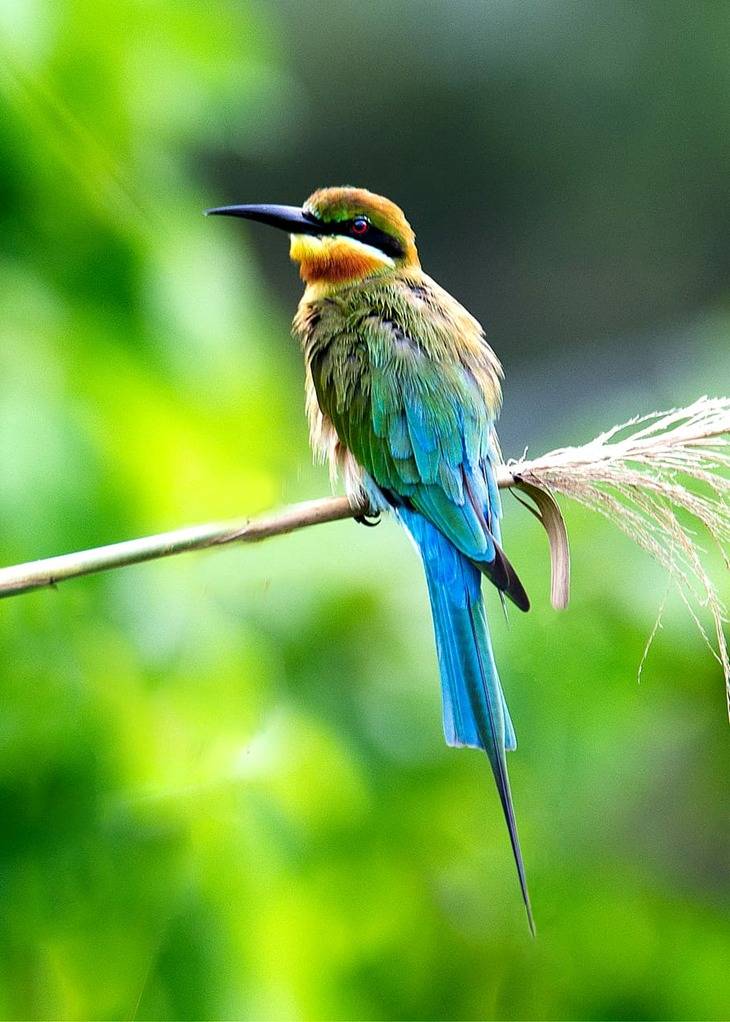
The mesmerizing migratory – Blue-Tailed Bee Eater (Merops phillippinus) නිල්පෙඳ බිඟුහරයා
World Migratory Bird Day was celebrated internationally on 14th May 2022. We celebrated with Mr Sarinda Unamboowe, well known wildlife enthusiast, bird photographer and former Director of BSL, talking to us about our feathered friends that fly to warmer climes for winter and then return home to breed. If you missed it, you can watch on:
https://fb.watch/c-94DFuBfw/
Every year, many bird species move thousands of kilometers. Migration is driven by the availability of food sources and more pleasant weather patterns. Places, where there is plenty of food and birds, may securely build nests. Flyways are the flying pathways that birds use during their annual migrations. A bird’s navigational ability is remarkable, while Scientists are not entirely sure how birds navigate their flyways.
Sri Lanka, a tropical island with various ecosystems, supplying yummy food for these tired travelers, making our country a favorite destination year-round stop for migrating birds.
While the number of migrants expected on our beaches is large, the arrival of the colorful and noticeable species marks the start of the “migration season.” Brightly colored bee-eaters are one of the most intriguing groups of birds among them. They may be found in most of the island’s national parks and bird sanctuaries. Their brightly colored feathers attract the attention of bird watchers.
The Little Green Bee Eater, Chestnut Headed Bee Eater, and Blue Tailed Bee Eater are the only three notable species of bee-eaters found in Sri Lanka.
The migratory Blue-tailed Bee Eaters are lovely to look at, with rich shades of blue and green, and gold on their plumage. They visit us from their breeding grounds in Southeast Asia. They don’t usually nest in trees. Instead, they build colonies on the sides of rivers or in open flat areas. They dig a long tunnel into which they lay approximately 5-7 white eggs.
They’re also known as the “Blue-cheeked Bee-eater” in various regions of the world. A thin blue patch with a black eye stripe and a yellow and brown throat are key distinguishing features on its face. The tail has a stunning iridescent blue color. It has two extended middle tail feathers and can grow to be 23-26 cm long. Both sexes are similar.
The majority of blue-tailed bee-eaters migrate, while small groups settle in the southeastern coastal area as permanent inhabitants. They inhabit the eastern shore of the island, from Bundala to Pottuvil. They may be seen in every corner of the island during the migratory season.
They are expert hunters. Bees, wasps, hornets, and dragonflies are among the insects they consume. Bird enthusiasts can enjoy seeing them demonstrating their aerial dexterity by snatching insects in mid-flight. Their magnificent aerial attacks provide wildlife photographers with a fantastic chance.
They detoxify wasps or bees before eating them. Surprisingly, this little bird can consume roughly 250 bees every day.
Sand bathing is something that bee-eater flocks do practically any day of the year. This is a necessary activity for bee-eaters, who appear to like the sensation of dust on their feathers. It is an attempt to clear their body of parasites.
As social creatures, they frequently appear in groups. Bee-eaters have a sophisticated social system. Many species show monogamy. The couples are highly attached and have been together for many years. Most bee-eater species share this remarkable habit known as courtship feeding. The male collects the prey and feeds his partner during courting.
Let’s ensure that we conserve our habitats so that these much-awaited visitors can enjoy our beautiful island!
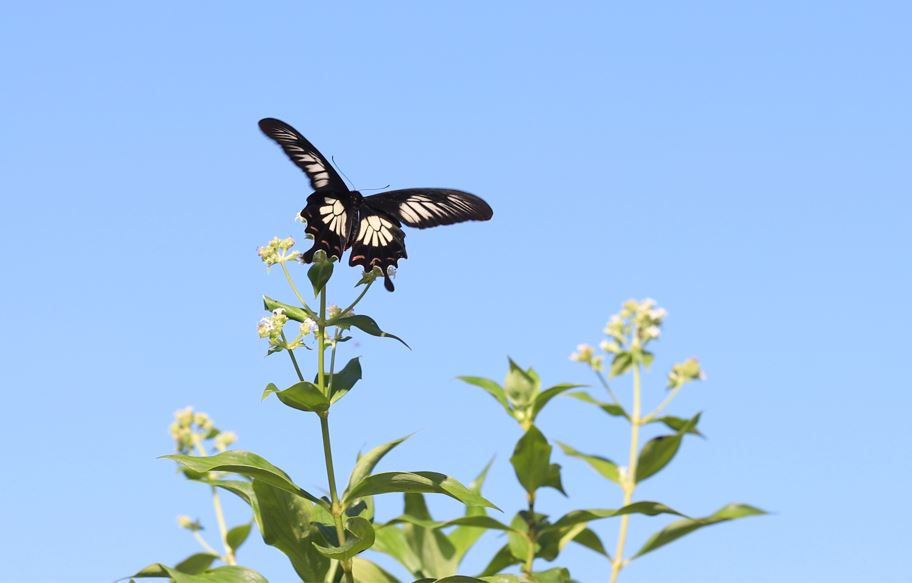
The story that butterflies tell you about ecological restoration….
Our LIFE Journey began four years ago in February 2018 with ten private sector companies partnering with Biodiversity Sri Lanka for restoration of a 10ha degraded forest land located in the Kanneliya Forest Reserve under the able guidance of IUCN and the Forest Department.
From trees…
After years of astute planning and rigorous implementation and monitoring, despite multiple challenges, the Project has shown remarkable progress in restoring this land. At the end of the fourth year of restoration, over 18,000 plants have been grown at the site from 46 plant species including Hora, Wal Del, Bata Domba, Alu bo, Naa, Pelan, and Diyapara. Some of the native shrub species (Maha bovitiya – Melastoma malabaricum and Veraniya – Hediotis fruticans) have emerged naturally in the site after the systematic removal of the invasive Kekilla. Also, the exotic species Alstonia (Alstonia macrophylla) has been observed alongside native shrub species. Despite, Alstonia being an invasive plant, for another couple of years, the Alstonia plants will be maintained to obtain shade and to increase the soil carbon level in the site. Some of the naturally occurred pioneering species include Milla, Kekuna, Kenda, and Geduma.
To butterflies…
Above all, one significant indication that the Project is heading in the right direction is the colonization of butterfly species at the restoration site. Lomove et al (2006) conclude that butterflies are a good indicator species to assess the progress of the ecological restoration. The comparison on the presence of butterfly species before restoration commenced and after four years of restoration is astounding. The biodiversity survey which was done before restoration work commenced in 2017 showed no records of butterflies at the site itself whilst 14 species of butterflies were recorded from the adjacent forest control plot. Nevertheless, a recent biodiversity survey has recorded 22 butterfly species at the restoration site. This remarkable development can be attributed to multiple reasons including the change in the habitat structure from a fern land to a shrub forest and the natural regeneration of plant species such as Weraniya and Maha Bovitiya.
Butterfly Species recorded at the restoration site were Tailed jay, Five bar swordtail, Bluebottle, Crimson rose, Blue Mormon, Ceylon birdwing, Lemon emigrant, Mottled Emigrant, and Jezebel. Three-spot grass yellow, One-spot grass yellow, Psyche, Tawny costor, Tree nymph, Grey pansy, Tree nymph, Chocolate soldier, Gladeye bush brown, White four-ring, Ceylon Cerulean, Yamfly, and Chestnut Bob., 06 of which are endangered species and the others being Indigenous.
This is exciting and remarkable news for us!
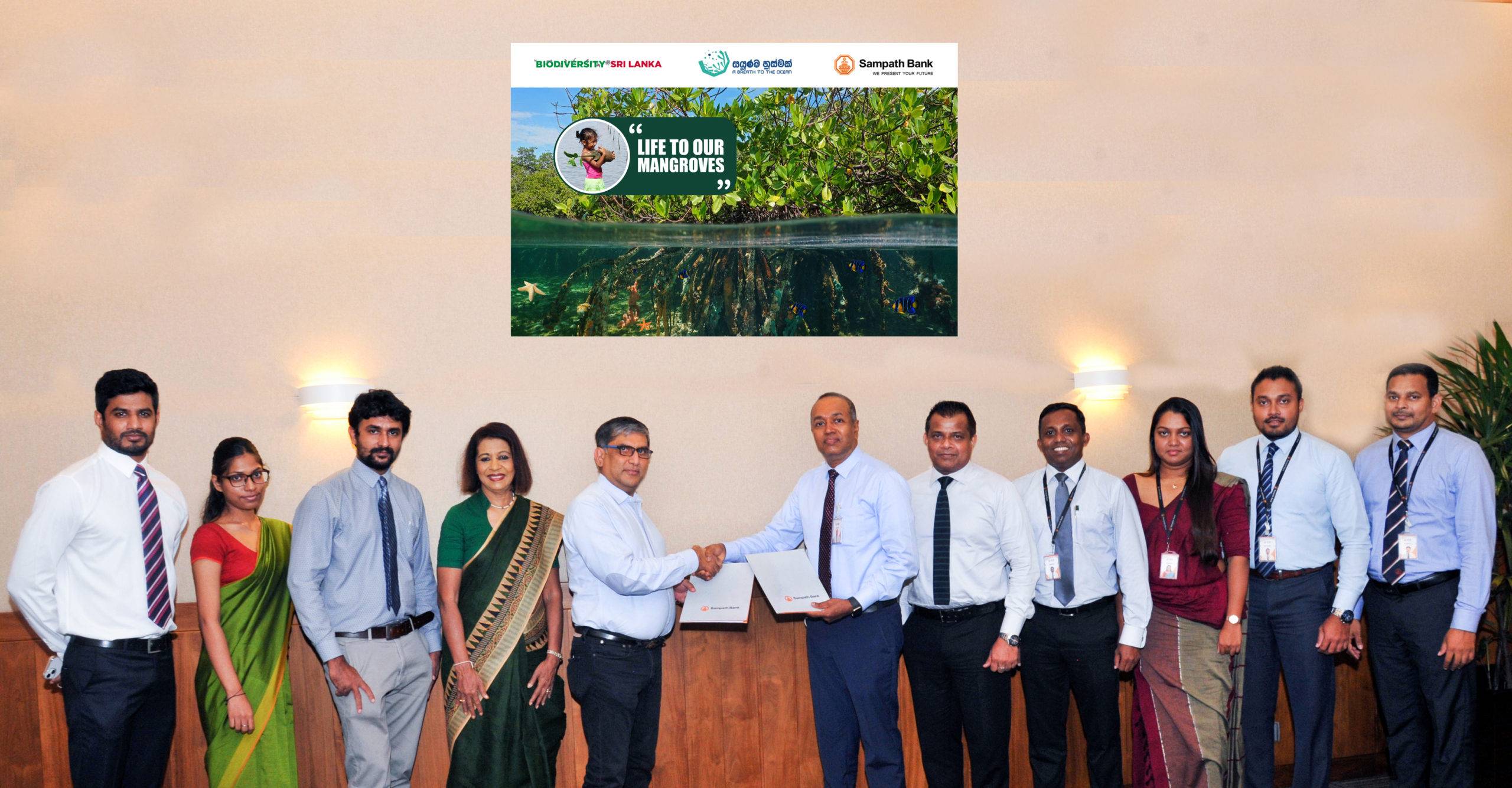
BSL signs a Partnership Agreement with its Patron Member – Sampath Bank LIFE TO OUR MANGROVES
Biodiversity Sri Lanka (BSL) and Sampath Bank PLC exchanged a Memorandum of Understanding to partner in the multi-partner mangrove restoration project as a Nature-based Solution (NbS) using a private-public partnership approach. The project is expected to generate multiple environmental as well as socio-economic benefits. Overall, the intervention will enhance the resilience of the mangrove ecosystem, its capacity for renewal, and the provision of ecosystem services, whilst contributing to the socio-economic development of local communities. The signing took place at the Sampath Bank Head Office by the Bank’s Group Chief Human Resources Officer Mr. Lalith Weragoda and Biodiversity Sri Lanka’s Director Mr. Shahid Sangani who is also the Managing Director of Dynawash Ltd.
On the 12th of December 2021, Biodiversity Sri Lanka and the Department of Wildlife Conservation (DWC) exchanged a Memorandum of Understanding (MoU) to implement this project. Mr. M. G. C. Sooriyabandara, Director-General of the Department of Wildlife Conservation, and Mr. Chandrarathna D Vithanage, Director of Biodiversity Sri Lanka, signed this document at the Department of Wildlife Conservation. The project ‘LIFE To Our Mangroves’ was officially launched on the 7th of February 2022 by Biodiversity Sri Lanka and its members.
Known as ‘the Lungs of the Sea’, mangrove ecosystems provide critical services for the maintenance and well-being of global biodiversity. They are also of equal importance to humans living in the tropical belt, in terms of the ecosystem services that they provide, and the options offered by them as livelihoods to the major proportion of populations that live in the coastal zones of the region. In the context of the single-most debilitating challenge that humankind faces currently, mangroves play a significant role in fighting climate change as unique and productive Carbon sinks, and by acting as a protective barrier for human settlements, against heightened natural disasters resulting from increased global temperatures. Therefore, there is the special and increased focus being laid on the conservation and wise use of mangrove ecosystems around the world.
Mangrove ecosystems cover a land area of 0.23% of the total land area of Sri Lanka. In order to prioritize the protection of these mangrove forests, and more so urgently – a national policy to conserve and sustainably utilize mangrove ecosystems in Sri Lanka, was approved by the Cabinet of Ministers in March 2020.
Anaiwilunda Wetland Sanctuary, which covers an area of 1,397 ha, consists of forest wetlands including mangroves, coastal saltwater ecosystems, and freshwater lakes. It is located along the coastal belt between Chilaw and Puttalam in the Northwestern Province of Sri Lanka. It is one of Sri Lanka’s six RAMSAR wetlands. The sanctuary provides shelter to a host of threatened fish, amphibians, mammals, reptiles, and many migratory birds.
From 44.5 ha of degraded mangrove forest patches within the sanctuary, the DWC has agreed to guide Biodiversity Sri Lanka in initially restoring up to 25 ha, using accepted scientific principles within a period of five years. BSL Members will play an active role in this effort. The first two years will focus on planning, forging community partnerships, land preparation, nursery establishment, and planting activities. Years three-five will be allocated for gap filling and maintenance. Activities will be guided by IUCN’s Global Nature-based Solutions Standard. Baseline monitoring for the entire site is being undertaken by the DWC and monitoring of the BSL site will be in keeping with this overall M&E process.
We look forward to a very fruitful partnership with the Bank!
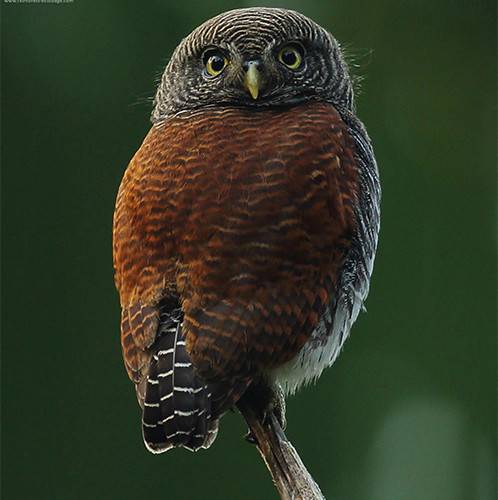
In commemoration of World Endangered Species Day
The third Friday in May every year is designated as Endangered Species Day. In commemoration, BSL hosted an educational session on endangered species for students from its Patron Member, Stafford International School Colombo. This event reminded us of how vulnerable some animals, plants, and insects are, and inspired us to learn more about why it is so vital to conserve them. This is a day when people talk about solutions and educate their families and friends about how they can help protect certain species. The session for senior students of the school was conducted by Professor Sampath Seneviratne from the Department of Zoology and Environmental Science of the University of Colombo a well-known Molecular Ecology, Evolution and Ornithology Research Scientist.
Several animals have come and gone or become extinct since life originated on Earth, owing to changing physical and biological conditions in the environment. Extinction, as we all know, is a continuous natural occurrence. However, scientific evidence suggests that the current pace of species loss is far faster than the historical rate. This is something we need to consider or is a cause for concern.
Sri Lanka, the pearl of the Indian Ocean has high species diversity, ranging from elephants and leopards to marine turtles and a vast number of birds. There is a big chance of seeing the mighty blue whale in our southern and eastern oceans. Even though Sri Lanka is famous for its wildlife there are a number of wild animal and plant species that are threatened with extinction because of human behavior. Sometimes these threatened flora and fauna go extinct and are lost forever.
Prof Sampath Seneviratne
The focus of the day’s program was on threatened and extinct species. Professor Seneviratne discussed the DNA distribution of certain extinct creatures, such as the clade Dinosauria – the common name given to a group of reptiles, often very large, that first appeared roughly 245 million years ago. Sri Lanka was a peninsula for most of the Indian geological history. Dinosaurs have been discovered on what was India’s northwest coast, present-day Gujarat and Madhya Pradesh. However, we did not discover Mesozoic rock in Sri Lanka because it has either been eroded away to reveal Precambrian rock or has been buried beneath layers of Cenozoic rock. The early human remains in Sri Lanka, for example, can be found in the Balangoda caves. The Mesozoic is represented only by two Jurassic Limestone patches in Puttalam. It is not impossible to find dinosaurs in coastal marine deposits, although none have been discovered so far.
(Picture Credit – The Rainforest Ecolodge – Sinharaja)
Referring to the present context, Professor Seneviratne mentioned that Sri Lanka has a higher number of endemic animal species, as well as one of the highest rates of biological endemism in the world. There are around 21 endemic mammals, 26 endemic birds, 113 endemic reptiles, 112 endemic amphibians, 50 endemic fish, and countless insect species in Sri Lanka, including 24 endemic butterflies such as Mycalesis Rama (Cingalese Bushbrown) and Elymnias Singhala (Ceylon Palm fly). The Sri Lankan junglefowl, Purple-faced langur, and the Sri Lanka Blue Magpie are some of the common endemic fauna, that can be observed in the country. The distribution of these animals across Sri Lanka varies depending on the country’s environmental variability. The Sinharaja World Heritage site is home to 21 of the 26 endemic bird species, making it one of the most endemism-rich ecosystems on the planet.
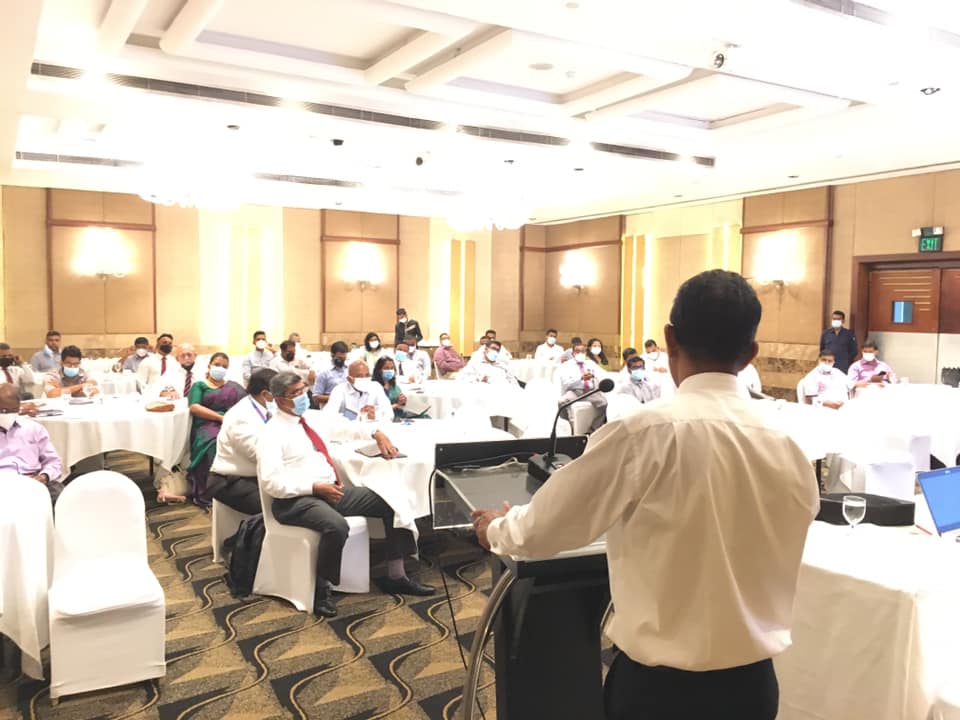
The Private Sector takes the lead in Extended Producer Responsibility (EPR) for Plastic Waste Management
The evolution of a dialogue on EPR for plastic waste management in Sri Lanka is considered a landmark, for finding common ground among stakeholders with divergent views on the subject. The Sri Lankan private sector was initially dissatisfied when a state-led EPR approach was mooted. Subsequently, even in the absence of legal provisions to impose EPR in the country, continuous and active involvement of the sector in developing and executing an industry-led, country-wide, plastic-type focused voluntary EPR scheme has led to a useful way forward.
Leading this dialogue, over the past few years, the Ceylon Chamber of Commerce (CCC), with the technical support of Biodiversity Sri Lanka, has been sensitizing the private sector on the critical need of introducing an EPR solution for addressing rapidly growing plastic waste in the country. With strategic direction provided by a multi-stakeholder steering committee, an EPR Roadmap was developed using a consultative approach. In this process, several sectoral stakeholder consultations targeting key industry sectors yielded some useful policy-level inputs and insights. Simultaneously, a review of global EPR practices from six countries helped to identify applicable EPR policy instruments for Sri Lanka.
The EPR Roadmap proposed three likely instruments for plastic waste management as applicable to Sri Lanka: A Deposit Refund System, an Advance Disposal Fee-based System, and a Mandatory Reporting and Collect-back System. The Roadmap also contained several over-arching proposals required to establish an efficient plastic waste management regime in Sri Lanka. A Perception Survey revealed that 90% of both government and private sector respondents endorsed the Roadmap whilst 80% of private-sector respondents expressed willingness to commit resources for the implementation of the preferred Mandatory Reporting and Collect-back System. These findings were complemented by Market and Socio-Economic Studies which provided useful information on the plastics value chain and consumer perceptions on handling plastic waste. Additionally, several key informant interviews provided more information and addressed information gaps. A consumer survey targeting 500 households across selected urban areas of the country, provided an understanding of the dynamics of household-level plastics waste management.
In moving forward, it is imperative to facilitate a continuous, transparent dialogue between all stakeholders in working out the finer details of the preferred Mandatory Reporting and Collect-back System. The Industrial sector is an effective intermediary in facilitating such a dialogue. The introduction of sudden and ad-hoc government decisions in the recent past, banning several plastic categories has contributed to many a debate among the state and private sectors on the merits and demerits of using a more holistic policy application. If EPR policy signals at the national level are not consistent, a situation may arise when the private sector may be reluctant to undertake long term investments to manage their plastic footprint. Contrary to empirical evidence, our studies show that Sri Lankan companies prefer individual EPR implementation strategies and approaches for plastic waste management, using a facilitated process under the guidance of the Government of Sri Lanka and industry associations. They can then employ their own innovative, plastic waste collection methodologies and channels and can also demonstrate commitment to minimizing plastic leakage to the environment, creating a positive brand image.
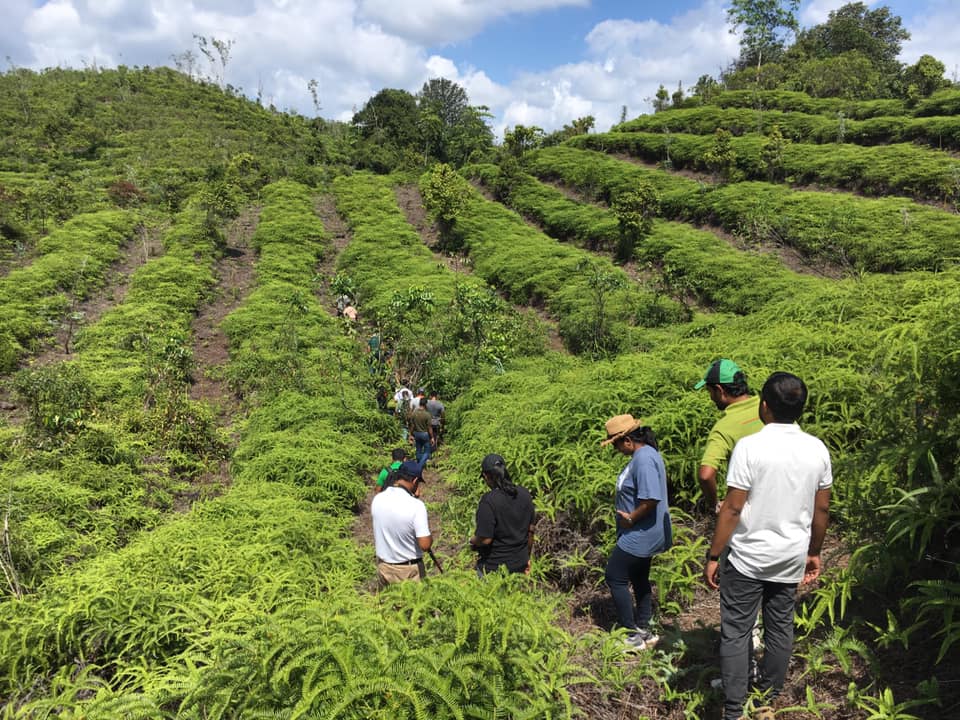
Bio credits: Incentives for Inclusive Biodiversity Conservation
(Read the full paper by Ina Porras and Paul Steele (IEED) 2019)
Tackling biodiversity loss is a growing priority for human survival. Introducing incentives for positive actions could play a key role in helping to reverse this loss. This paper explores the potential of using a novel approach to promote biodiversity conservation. Biodiversity credits or ‘bio credits’ are coherent units of measurement that track conservation actions and outcomes and can help improve tracking and transparency. Well-designed, they can make investments in biodiversity management more financially attractive, for example, by attracting private-sector finance. They can be used by governments to monitor their actions and report on biodiversity commitments. And as much of the world’s biodiversity and its richest biodiversity spots are often found in remote and poor tropical regions, we also argue that bio credits need to be inclusive, and founded on fair benefit sharing principles.
Tackling biodiversity loss is emerging as a growing priority for human survival. New data has revealed unequivocal links to ecological and economic tipping points. As a result, there is a renewed sense of urgency for institutions and systems to protect, restore and enhance biodiversity. As with carbon credits to control greenhouse gas (GHG) emissions, biodiversity credits – ‘bio credits’ – are a way to finance biodiversity improvements. Bio credits can be measured, tracked, and sold to raise funding which can be used as incentives for biodiversity conservation. Special attention in its design can also result in (inclusive) solutions to deliver local benefits to poor households. Bio credits are similar in the design to biodiversity offsets (used in the USA, Australia and the UK, for example). But they differ in use.
Bio credits are not designed to offset or compensate for actions with negative impacts on biodiversity elsewhere. In this sense, they are less contentious and do not depend on strict (and often unfeasible) legislation. In addition, few countries have national systems in place to promote and monitor biodiversity offsets. Even fewer of these systems are applicable to developing countries, where local inclusion and fairly sharing benefits are particularly important. This discussion paper examines the potential for developing countries to put in place a national scheme of bio credits that can be domestically and internationally sold, and which promotes fair benefit sharing with rural populations. The paper draws lessons from related incentives schemes which exist in carbon markets, especially REDD+ and voluntary community carbon offsets, as well as from wider examples of payments for ecosystem services (PES) schemes. Much can be learned from experiences with these related incentive schemes, which include species conservation banking (USA), eco-credits (Germany), a national PES scheme (Costa Rica), and wildlife credits (Namibia).
Based on the literature reviewed, we identified ways to develop a national bio credit scheme in a developing country. To date, no such bio credit scheme exists, but this paper sets out four key building blocks or characteristics needed to implement such a scheme:
- Simple, transparent, and cost-effective design
- Enabling policy from the government for implementation
- Market engagement to attract buyers and generate sales, and
- Inclusive and fair benefits for local people.
With the growing emphasis on biodiversity in the run-up to the 2020 United Nations Biodiversity Conference, it is likely that interest in incentive-type mechanisms such as bio credits will only grow. Done properly, bio credits may develop into a viable option to improve biodiversity conservation and reduce poverty.
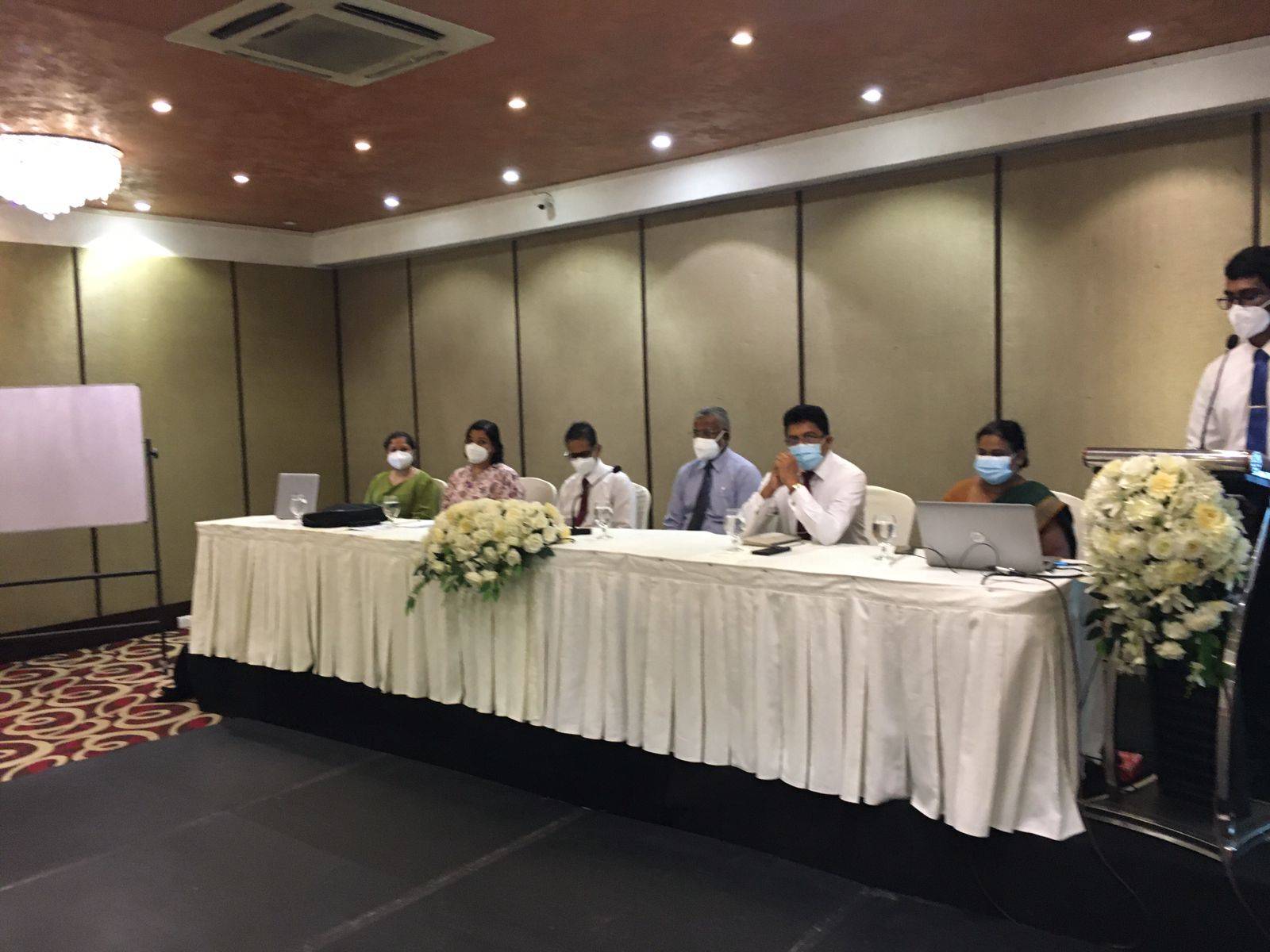
A Capacity Building Tool-kit for Collectors/Recyclers
The Project “Enhancing Extended Producer Responsibility (EPR) through a Public-Private Partnership Approach” which is implemented by the Ceylon Chamber of Commerce (CCC) in partnership with Biodiversity Sri Lanka (BSL) with the endorsement of the Ministry of Environment (MoE) conducted a Training of Trainers workshop to introduce a Capacity Building Toolkit on waste collection/ recycling to the field staff of the Central Environmental Authority (CEA) and the Western Provincial Waste Management Authority (WPWMA) on February 25, 2022, at Grand Monarch, Thalawathugoda.
The main objective of the workshop was to impart knowledge on plastic waste collection and recycling among the staff of CEA and WPWMA and through them transfer knowledge to collectors/ recyclers in Sri Lanka. The trained persons will conduct a series of training programs targeting collectors and recyclers registered with CEA and WPWMA. This Capacity Building Toolkit was developed with the support of the National Cleaner Production Centre – Sri Lanka (NCPC Sri Lanka) under the USAID-funded Municipal Waste Recycling Project (MWRP).
Mr. Chandrarathna D Vithanage, Senior Assistant Secretary-General, CCC/Project Manager welcomed the participants and Ms. Nihani Riza, Project Management Specialist from the Office of Economic Growth, USAID Mission and Eng. J. M. U. Indrarathne, Deputy Director-General, Waste Management Division, CEA delivered opening remarks. Ms. Riza provided a quick overview of USAID’s efforts in tackling plastic waste issues globally. She was thankful to the Clean Cities Blue Ocean (CCBO) Program’s partners for contributing to achieve the goals of sustainable consumption and production, waste management, pollution reduction, climate change mitigation, and human health advancement. Mr. Indrarathne emphasized on the negative impacts that plastics generate on ecology across the world. He stated that Sri Lanka has enacted several regulations between 2017 and 2020 to address the plastic waste issue. Whilst recognizing the importance of the toolkit to build technical capabilities and financial prospects of collectors/ recyclers in Sri Lanka, he thanked USAID, the CCBO project, and the CCC for undertaking this all-important initiative.
The resource personnel from NCPC introduced the Capacity Building Toolkit to the participants. Following the introductory presentation, group work enabled the participants to present various chapters of the toolkit. The objective of this session was to ensure familiarity with its contents. The post-lunch session was entirely dedicated to a group case study on recycling operations. The participants were asked to identify regulatory matters, technical and financial considerations, environmental and social aspects, and cost calculations of recycling operations based on the details given in the case study. All the groups calculated cost efficiencies correctly and some of them came up with economically viable suggestions through which the cost of recycling operations can be reduced.
The workshop saw active and enthusiastic participation of the CEA and WMA staff. One of the highlights was when making presentations by the participants, using examples from their practical experiences, which is a positive case in transmitting knowledge to collectors and recyclers. During the last session of the workshop, a plan was discussed to organize three capacity-building workshops for collectors and recyclers in Colombo, Gampaha, and Kalutara Districts during the next two months.
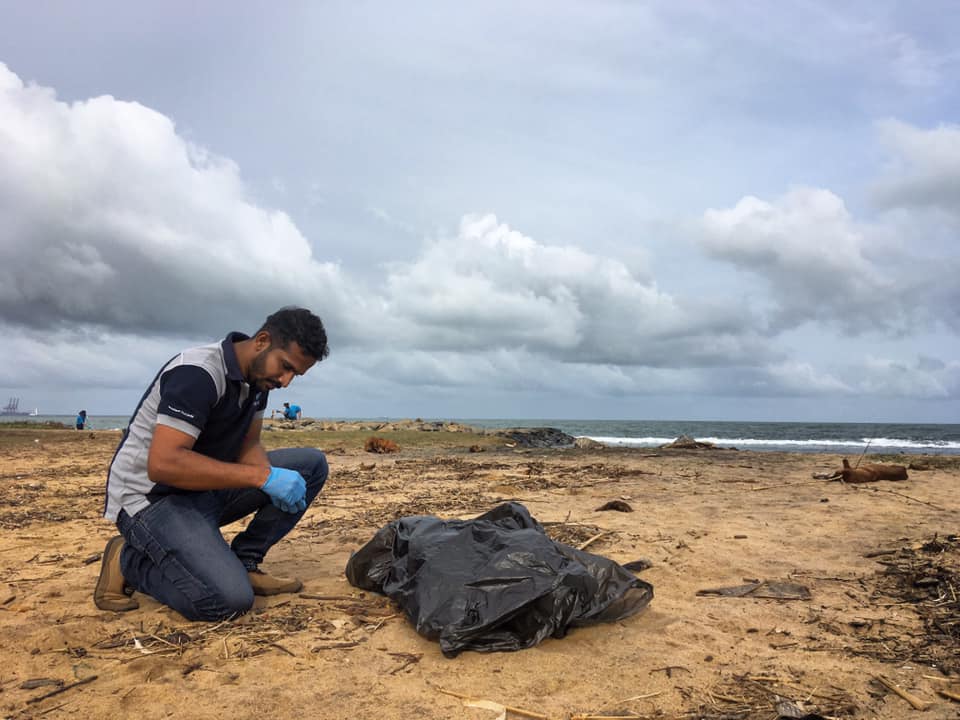
Giving LIFE to Our Beaches – A Public – Private – Community Partnership
As an island nation, Sri Lanka boasts of a coastline extending over 1,300km. A little-known fact is that our coastal and marine area is approximately 8 times the total land area of our country. With 103 rivers debouching into the ocean, approximately 85% of marine litter, originates from mismanaged, land-based, human activities. With a wave and tidal action, this litter accumulates on beaches posing threats and risks to industries and livelihoods that depend upon them as well as to the general aesthetic beauty of our island nation – known the world over as a beach paradise!
To maximize sustainable utilization of our beaches, it is imperative that we take measures to keep them clean and free of hazards allowing for free public movement and recreation. The solid waste which is found on our shores is often not only of local origin but also washed up from overseas. Plastic, glass, aluminum, and rubber-based material, if collected and directed appropriately, can be turned into valuable resources through upcycling and recycling. Mismanagement of plastic waste can result in leaching and the generation of microplastics, which via the food chain can re-accumulate, threatening the safety and wellbeing of coastal and marine fauna. It is also an imminent health hazard.
Given that urgent action is needed to ensure that our beaches are constantly monitored, cleaned, and managed sustainably – with the involvement of all stakeholders, BSL led by the Marine Environment Protection Authority (MEPA) has launched Life to Our Beaches – a program to clean and maintain selected beach stretches. Community involvement is an indispensable component in maintaining beaches. It is an opportunity for local coastal communities to generate an additional income whilst contributing to a worthy national cause. It is not just collecting trash from the beaches. It goes beyond sensitizing and educating coastal communities on solid waste management whilst contributing to improving their living standards.
Community members, who will act as beach caretakers under this program, are Samurdhi beneficiaries. They will be trained on waste collection and segregation. The collected recyclable/ reusable plastic waste will be sold to recyclers so that community members can directly gain an additional income. Increasing plastic waste collection will also contribute to increasing national plastic waste recycling rates, which are currently significantly low. This will also improve circular economic activities. When coastal stretches are maintained clean and healthy, local, and international visitors will make frequent visits to these destinations so that associated communities can set up new businesses targeting visitors. This will be a boost to the local economy.
We invite you to join hands with BSL in its Life to Our Beaches Program – Contact us for more information.

BSL’s Biodiversity Project Ranking Scheme (BPRS) – a pathway to sustainable projects!
BSL urges all companies engaged in biodiversity-related projects to get them ranked, thus improving designing, implementation, and monitoring.
As in other Asian economies, in Sri Lanka, the private sector is the engine of growth. Sustaining high economic growth rates and improving the lives of the poor or marginalized communities whilst not compromising on environmental conservation and management is one of the biggest challenges facing growing economies. Many of the services that biodiversity and ecosystems provide are currently severely threatened. Safeguarding Sri Lanka’s biological diversity is integral to sustainable development, competitiveness, economic growth, and employment.
Some of the larger multinational and national companies operating in the country have included environmental and social dimensions into their growth agenda. A scoping study undertaken by Biodiversity Sri Lanka (BSL) in 2018 revealed that the private sector is increasingly taking an active role in environmental sustainability and biodiversity conservation issues both within and outside of its core business. Most initiatives in this direction are either carried out internally by companies themselves with the assistance of specialized non-governmental organizations, or by direct links with state institutions. Significant advancements have been made and some best practices and outstanding projects have been recognized by recent award schemes. These worthy examples have displayed sustained commitment, serving as inspirations to others. However, it is recognized that a large number of projects still do not realize their intended goals and objectives, leaning towards non-optimum use of much needed resources.
Much of these projects are designed on the assumption that they will lead to conservation of key biological resources. Hence, monitoring, evaluation, and assessment are primary tools to determine whether they are meeting intended targets and objectives. Such assessments may also serve as useful reference materials for government agencies, non-governmental organizations, and others involved in the design, implementation, or evaluation of biodiversity/ environmental projects. Thus, more attention must be paid to drive the private sector to incorporate well-defined scientific approaches in projects, devise action plan-based operations including community involvement, and achieving core objectives by defining suitable methodologies that recognizes the importance of these projects in addressing national biodiversity conservation priorities
In this context, Biodiversity Sri Lanka’s (BSL) Biodiversity Project Ranking Scheme (BPRS) was developed to aid private sector companies in improving the design and implementation of biodiversity conservation-related projects. This scheme endeavors to ensure that private sector-led biodiversity conservation projects, support national conservation efforts and maximizes the positive impacts of such projects on conserving and managing the country’s national biological heritage. A Project Ranking Support Manual aims at helping project planners, managers, implementers, and monitors to further understand the BPRS criteria, and to assist in ensuring that the design and implementation of a project is in line with the requirements of the scheme. Through pilot testing, this scheme has been refined to enable users to utilize it not only as a means of ranking projects nearing completion or are in its final stages but also in project design.
Following the audit of a project by our Auditor Bank of eminent scientists, respective companies will be awarded a Star Rank and exclusive use of the Project Ranking Logo.
Do not miss this valuable opportunity – Contact us!












